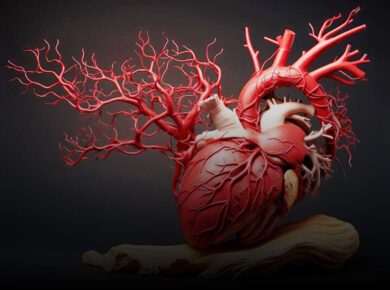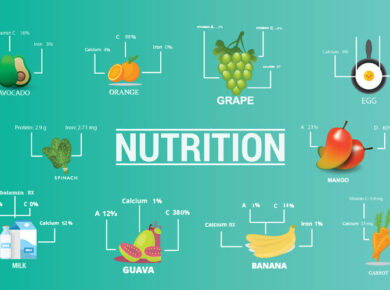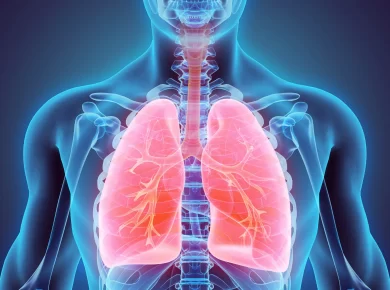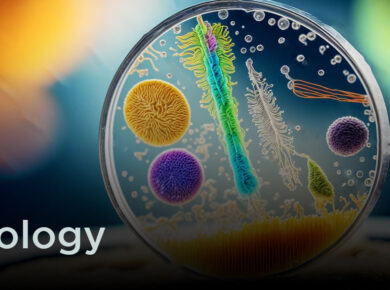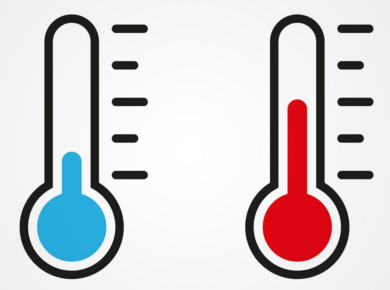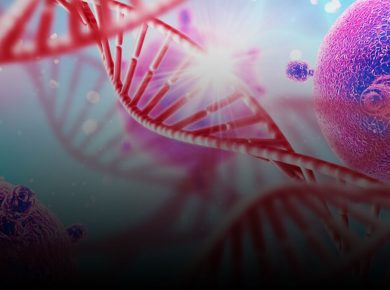Foundations of Modern Biology
Much of modern biology can be encompassed within five unifying principles: Cell theory, Evolution, Genetics, Homeostasis and Energy.
Cell Theory
Cells in culture, stained for keratin (red) and DNA (green)
Cell theory states that the cells is the fundamental unit of life and that all living things are composed of one or more cells or the secreted products of those cells (e.g. shells). All cells arise from other cells through cell division. In multicellular organisms every cell in the organism’s body derives ultimately from a single cell in a fertilized egg. The cell is also considered to be the basic unit in many pathological processes. Additionally, the phenomenon of energy flow occurs in cells in processes that are part of the function known as metabolism. Finally, cells contain hereditary information (DNA) which is passed from cell to cell during cell division.
Evolution
Natural selection of a population for dark coloration.
A central organizing concept in biology is that life changes and develops through evolution and that all life forms known have a common origin. Introduced into the scientific lexicon by Lamarck in 1809, evolution was established by Charles Darwin fifty years later as viable theory when he articulated its driving force; Natural Selection (Alfred Russel Wallace is recognized as the co-discoverer of this concept as he helped research and experiment with the concept of evolution). Evolution is now used to explain the great variation of life found on Earth.
Darwin theorized that species and breeds developed through the processes of natural selection and artificial selection or selective breeding. Genetic drift was embraced as an additional mechanism of evolutionary development in the modern synthesis of the theory.
The evolutionary history of the species- which describes the characteristics of the various species from which it descended together with its genealogical relationship to every other species is known as its phylogeny. Widely varied approaches to biology generate information about phylogeny. These include the comparisons of DNA sequences conducted within molecular biology or genomics, and comparisons of fossils or other records of ancient organisms in paleontology. Biologists organize and analyze evolutionary relationships through various methods, including phylogenetics, phenetics and cladistics.
The theory of evolution postulates that all organisms on the Earth, both living and extinct, have descended from a common ancestor or an ancestral gene pool. This last universal common ancestor of all organisms is believed to have appeared about 3.5 billion years ago. Biologists generally regard the universality and ubiquity of the genetic code as definitive evidence in favor of the theory of universal common descent for all bacteria, archaea and eukaryotes.
Genetics
Punnett square depicting a cross between two pea plants heterozygous for purple (B) and white (b) blossoms Genes are the primary units of inheritance in all organisms. A gene is a unit of heredity and corresponds to a region of DNA that influences the form or function of an organism in specific ways.
All organisms, from bacteria to animals, share the same basic machinery that copies and translates DNA into proteins. Cells transcribe a DNA gene into an RNA version of the gene and a ribosome then translates the RNA into a protein a sequence of amino acids. The translation code from RNA codon to amino acid is the same for most organisms, but slightly different for most organisms, but slightly different for some. For example, a sequence of DNA that codes for insulin in humans also codes for insulin when inserted into other organisms, such as plants.
DNA usually occurs as linear chromosomes in eukaryotes, and circular chromosomes in prokaryotes. A chromosomes is an organized structure consisting of DNA and histones. The set of chromosomes in a cell and any other hereditary information found in the mitochondria, chloroplasts or other location is collectively known as its genome.
In eukaryotes, genomic DNA is located in the cell nucleus, along with small amounts in mitochondria and chloroplasts. In prokaryotes, the DNA is held within an irregularly shaped body in the cytoplasm called the nucleoid. The genetic information in a genome is held within genes and the complete assemblage of this information in an organism is called its genotype.
Homeostasis
The hypothalamus secretes CRH, which direct the pituitary gland to secrete ACTH. In turn, ACTH directs the adrenal cortex to secrete glucocorticoids, such as cortisol. The GCs then reduce the rate of secretion by the hypothalamus and the pituitary gland once a sufficient amount of GCs has been released.
Homeostasis is the ability of an open system to regulate its internal environment to maintain stable conditions by means of multiple dynamic equilibrium adjustments controlled by interrelated regulation mechanisms. All living organisms, whether unicellular or multicellular, exhibit homeostasis.
To maintain dynamic equilibrium and effectively carry out certain functions, a system must detect and respond to perturbations. After the detection of a perturbation, a biological system normally respond through negative feedback. This means stabilizing conditions b;y either reducing or increasing the activity of an organ or system. One example is the release of glucagon when sugar levels are too low.
Energy
The survival of a living organism depends on the continuous input of energy. Chemical reaction that are responsible for its structure and function are tuned to extract energy from substances that act as its food and transform them to help form new cells and sustain them. In this process, molecules of chemical substances that constitute food play two roles; first, they contain energy that can be transformed for biological chemical reactions; second they develop new molecular structures made up of bio-molecules.
The organisms responsible for the introduction of energy into an ecosystem are known as producers orautotrophs. Nearly all of these organisms originally draw energy from the sun. Plants and other phototrophsuse solar energy via a process known as photosynthesis to convert raw materials into organic molecules, such as ATP, whose bonds can be broken to release energy. A few ecosystems, however; depend entirely on energy extracted by chemotrophs from methane, sulfides or other non-luminal energy sources.
Some of the captured energy is used to produce biomass to sustain life and provide energy for growth and development. The majority of the rest of this energy is lost as heat and waste molecules. The most important processes for converting the energy trapped in chemical substances into energy useful to sustain life are metabolism and cellular respiration.

